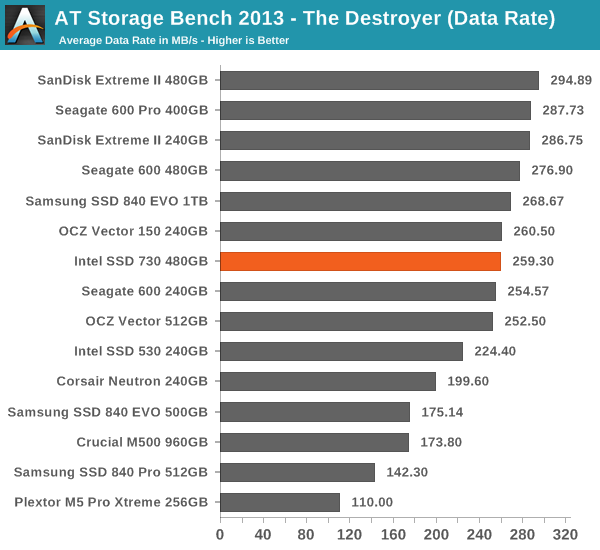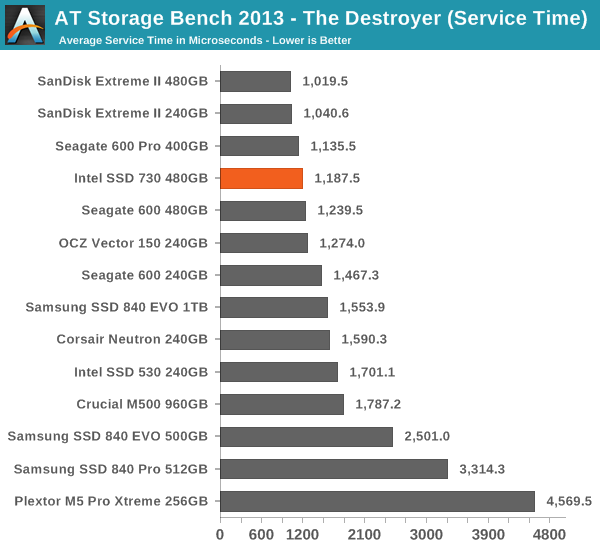Intel SSD 730 (480GB) Review: Bringing Enterprise to the Consumers
by Kristian Vättö on February 27, 2014 12:00 PM EST- Posted in
- Storage
- SSDs
- Intel
- Intel SSD 730
AnandTech Storage Bench 2013
Our Storage Bench 2013 focuses on worst-case multitasking and IO consistency. Similar to our earlier Storage Benches, the test is still application trace based—we record all IO requests made to a test system and play them back on the drive we're testing and run statistical analysis on the drive's responses. There are 49.8 million IO operations in total with 1583.0GB of reads and 875.6GB of writes. As some of you have asked, I'm not including the full description of the test for better readability, so make sure to read our Storage Bench 2013 introduction for the full details.
| AnandTech Storage Bench 2013 - The Destroyer | ||||||||||||
| Workload | Description | Applications Used | ||||||||||
| Photo Sync/Editing | Import images, edit, export | Adobe Photoshop CS6, Adobe Lightroom 4, Dropbox | ||||||||||
| Gaming | Download/install games, play games | Steam, Deus Ex, Skyrim, Starcraft 2, BioShock Infinite | ||||||||||
| Virtualization | Run/manage VM, use general apps inside VM | VirtualBox | ||||||||||
| General Productivity | Browse the web, manage local email, copy files, encrypt/decrypt files, backup system, download content, virus/malware scan | Chrome, IE10, Outlook, Windows 8, AxCrypt, uTorrent, AdAware | ||||||||||
| Video Playback | Copy and watch movies | Windows 8 | ||||||||||
| Application Development | Compile projects, check out code, download code samples | Visual Studio 2012 | ||||||||||
We are reporting two primary metrics with the Destroyer: average data rate in MB/s and average service time in microseconds. The former gives you an idea of the throughput of the drive during the time that it was running the test workload. This can be a very good indication of overall performance. What average data rate doesn't do a good job of is taking into account response time of very bursty (read: high queue depth) IO. By reporting average service time we heavily weigh latency for queued IOs. You'll note that this is a metric we've been reporting in our enterprise benchmarks for a while now. With the client tests maturing, the time was right for a little convergence.

Even though the performance consistency on the SSD 730 is great, it's only mediocre in our Storage Bench 2013. The write performance of SSD 730 is class-leading but as our Storage Bench has more read than write operations, the SSD 730 loses to drives with better read performance. Whether the drive should focus on read or write performance is a question with no single correct answer because it's workload dependent. The heavy enterprise workloads the SSD 730 platform was designed for tend to be more aggressive in writes, so giving up some read performance makes sense there and carries over into the consumer version.











96 Comments
View All Comments
emn13 - Sunday, March 2, 2014 - link
It's interesting to note that both Crucial's M500 and intel's 730 have power-loss protection and a fairly high idle power. Does power-loss protection imply a high idle power?Kristian Vättö - Sunday, March 2, 2014 - link
The M500 supports low-power states (HIPM+DIPM) so in a mobile environment the power consumption is much lower: http://www.anandtech.com/bench/SSD/732hojnikb - Wednesday, March 5, 2014 - link
Is this related to devsleep or do older chipsets support that kind of low power consumption aswell ?Because in some reviews, m500 has quite high idle power consumption...
Kristian Vättö - Wednesday, March 5, 2014 - link
This isn't DevSleep, it lower the idle power consumption even more. This is just HIPM+DIPM (Host/Device Initiated Link Power Management), which is supported by older chipsets as well. However, note that only mobile chipsets support HIPM+DIPM, which is why the power consumption is significantly higher when tested in a desktop environment (like most reviewers do).amddude10 - Friday, November 28, 2014 - link
The power loss protection in crucial drives like the m500 is supposedly very incomplete, and not nearly as good as it is with the 730, or in enterprise drives, so its comparing apples and oranges. I would however say that SSD's which are going to be used in laptops are in much less need of power loss protection, but more in need of low power consumption, whereas SSD's that are intended for desktop use don't need low power consumption, and are in much higher need of power loss protection.CeceliaAFolger - Sunday, March 2, 2014 - link
hywoolfe9998 - Sunday, March 2, 2014 - link
This doesn't strike me as an especially impressive product given what is already out there. Frankly, it seems that SSD technology has settled to the point where the only thing that matters any more is price/capacity. Find me half TB SSD for $200 and I'll care.hojnikb - Wednesday, March 5, 2014 - link
U can get m500 480GB for ~250$ or less if u find a deal. Thats pretty cheap, if you ask me..RAYBOYD44 - Monday, March 3, 2014 - link
til I looked at the receipt for $5432 , I accept that...my... cousin had been truley bringing home money part-time on there computar. . there aunts neighbour had bean doing this for only about 1 year and just paid for the mortgage on their home and purchased BMW M3 .Neo Zuko - Monday, March 3, 2014 - link
I was a big fan of the Sata II Intel SSDs but for Sata III I switched to the Samsung 830 Pro and then the Samsung 840 Pro as my SSD of choice. Seems it's time change up again to the SanDisk Extreme II (which was mentioned to be the new favorite SSD) and or the Intel 730 here.However the Intel 730, for all it does well, does not seem to be completely optimized for the average home PC workload and the top performance is suffering. And you can't use it in a laptop. These seem to be big deal breakers to me. Given those limitations it seems the SanDisk Extreme II would still be Anandtech's favorite SSD. Did I get that right? And would the SanDisk Extreme II work well in a PS4 without trim? And as an aside, I would not mind a better paragraph as to why the SanDisk is a favorite. Is it the near Intel constancy combined with the fast performance - like a best of both worlds thing? Also when is SanDisk releasing that enterprise lite version of the Extreme II with power failure features?